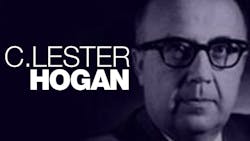C. Lester Hogan: Chemist Mixes The Right Formula For Electronics Success
It’s hard to fathom how a chemical engineer might turn out to be a pioneer in both microwave and semiconductor technology, but that’s just what Clarence Lester “Les” Hogan achieved. After graduating from Montana State University with his degree in chemical engineering, he joined the United States Navy in 1942. He ended up working with Bell Labs’ scientists developing an “acoustic torpedo” that found its target by following the sound of a ship.
Though Bell Labs offered Hogan a job after he left the military, he chose to go to Lehigh University and complete a PhD in physics in 1950. He then rejoined Bell Labs, where he invented, during his first three months on the job, the microwave gyrator, a device that can simulate inductance by substituting an RC circuit, eliminating awkward coil assemblies.
In 1953, Hogan accepted the Gordon McKay professorship at Harvard, where he guided nine students to doctorates while turning down many job offers to return to industry. In 1958, Motorola’s Dan Noble finally recruited him as vice president and general manager of the semiconductor operation.
In 1968, Hogan moved to Fairchild Camera & Instrument as chairman and CEO. The company attracted him with a lucrative stock option plan that became known in the industry as a “Hogan.” He also brought seven of his associates from Motorola—a team that was known as Hogan’s Heroes, after the TV show. Motorola sued Fairchild over this for theft of trade secrets, but was unsuccessful in its suit. Hogan retired in 1985.
Hogan served as a member of the board of directors of several corporations and was active on scientific and government advisory committees. His achievements have been widely recognized by a number of national and international organizations, particularly the Frederik Philips Gold Medal from the IEEE in 1976 and the MTT-S Microwave Pioneer Award in 1993.
In 1996, the University of California, Berkeley, named a chair at the department of Electrical Engineering and Computer Science in his honor. In 1999, he was inducted as an “Eminent Member” of Eta Kappa Nu, “the society’s highest membership classification, to be conferred upon those select few whose technical attainments and contributions to society through leadership in the field of electrical and computer engineering have resulted in significant benefits to humankind.”
In a memorial posted on Palo Alto Online, Hogan’s daughter, Cheryl Lea Hogan, said that from her father she “learned about sound, telescopes, microscopes, cameras, light, poetry, math, cooking, magnets, gardening, how to laugh, and how to be present in the moment.” He died in 2008 at the age of 88 due to complications of Alzheimer’s disease at his home in Atherton, Calif.
About the Author
Staff
Articles, galleries, and recent work by members of Electronic Design's editorial staff.
